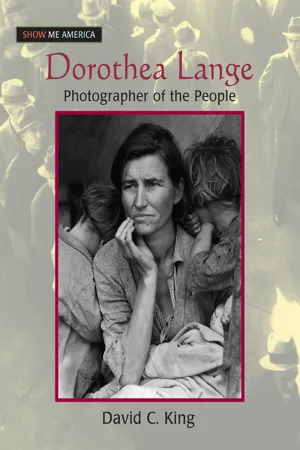
This is a test
- 88 pages
- English
- ePUB (mobile friendly)
- Available on iOS & Android
eBook - ePub
Book details
Book preview
Table of contents
Citations
About This Book
A scholarly work that aims to be both broad enough in scope to satisfy upper-division undergraduates studying folk belief and narrative and detailed enough to meet the needs of graduate students in the field.
Frequently asked questions
At the moment all of our mobile-responsive ePub books are available to download via the app. Most of our PDFs are also available to download and we're working on making the final remaining ones downloadable now. Learn more here.
Both plans give you full access to the library and all of Perlego’s features. The only differences are the price and subscription period: With the annual plan you’ll save around 30% compared to 12 months on the monthly plan.
We are an online textbook subscription service, where you can get access to an entire online library for less than the price of a single book per month. With over 1 million books across 1000+ topics, we’ve got you covered! Learn more here.
Look out for the read-aloud symbol on your next book to see if you can listen to it. The read-aloud tool reads text aloud for you, highlighting the text as it is being read. You can pause it, speed it up and slow it down. Learn more here.
Yes, you can access Dorothea Lange by David C King in PDF and/or ePUB format, as well as other popular books in History & World History. We have over one million books available in our catalogue for you to explore.
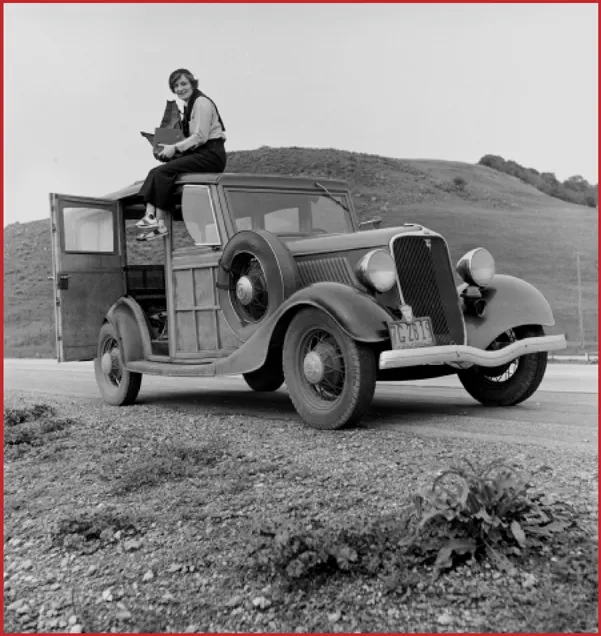
Lange holds her camera on her favorite perch for taking pictures.
CHAPTER ONE
A Photographer’s First Observations
I invented my own photographic schooling as
I went along, stumbling into most of it.
—Dorothea Lange
Dorothea Margarette Nutzhorn was born in 1895 in Hoboken, New Jersey, to a well-to-do German American family. The first few years of her life were comfortable and happy. Her father, Henry Nutzhorn, was a successful lawyer. They lived in a substantial brownstone house. Hoboken was a small, quiet port town across the Hudson River from New York City.
Two events shattered the normality of her childhood, and both left painful scars that would shape her life. In 1902, when she was seven (a year after her brother, Martin, was born), Dorothea was stricken with polio, also known as infantile paralysis. It was a frightening and painful disease, with no known cause or cure. For days, her young body was wracked with fever and pain.
Dorothea survived the illness, but her right leg was permanently damaged, leaving her with a severe limp that could never be corrected. The limp made her painfully self-conscious, especially when neighborhood children teased her and called her “Limpy.” Her mother made things worse by loudly telling her to walk straighter when they met people on the street.
“I think it perhaps was the most important thing that happened to me,” Dorothea later recalled. “It formed me, guided me, instructed me, helped me, and humiliated me. All those things at once. I’ve never gotten over it, and I am aware of the force and the power of it.”
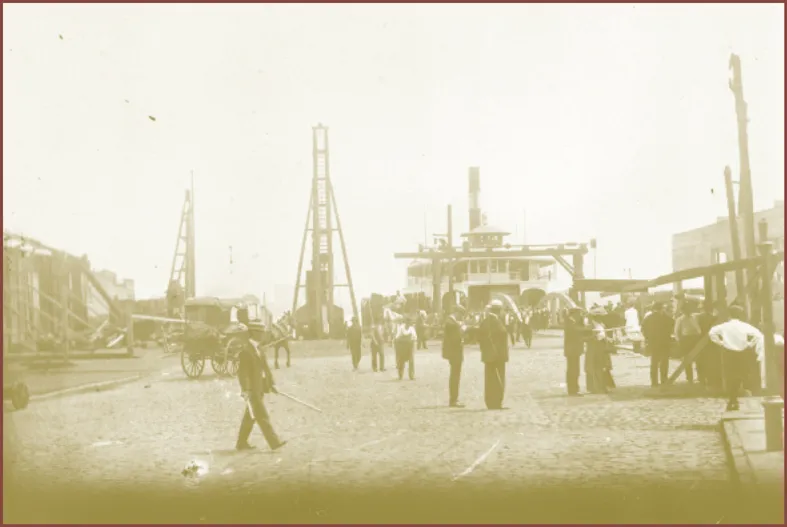
Dorothea and her mother rode the ferry every day from the Hoboken Ferry Port across the Hudson River to Manhattan.
Five years later, when Dorothea was twelve, the second devastating event occurred when her father abandoned the family without a word. He left no address or money, and they never heard from him again. The family was left penniless and had to move in with Dorothea’s grandmother, Sophie Lange, a skilled dressmaker. In response to the pain of her father’s abandonment, Dorothea dropped his name, Nutzhorn, and took her grandmother’s name of Lange.
To support the family, Dorothea’s mother, Joan, got a job at the New York Public Library. She enrolled Dorothea in a New York City school, and, each morning, she and her daughter took the ferry from Hoboken to Manhattan.
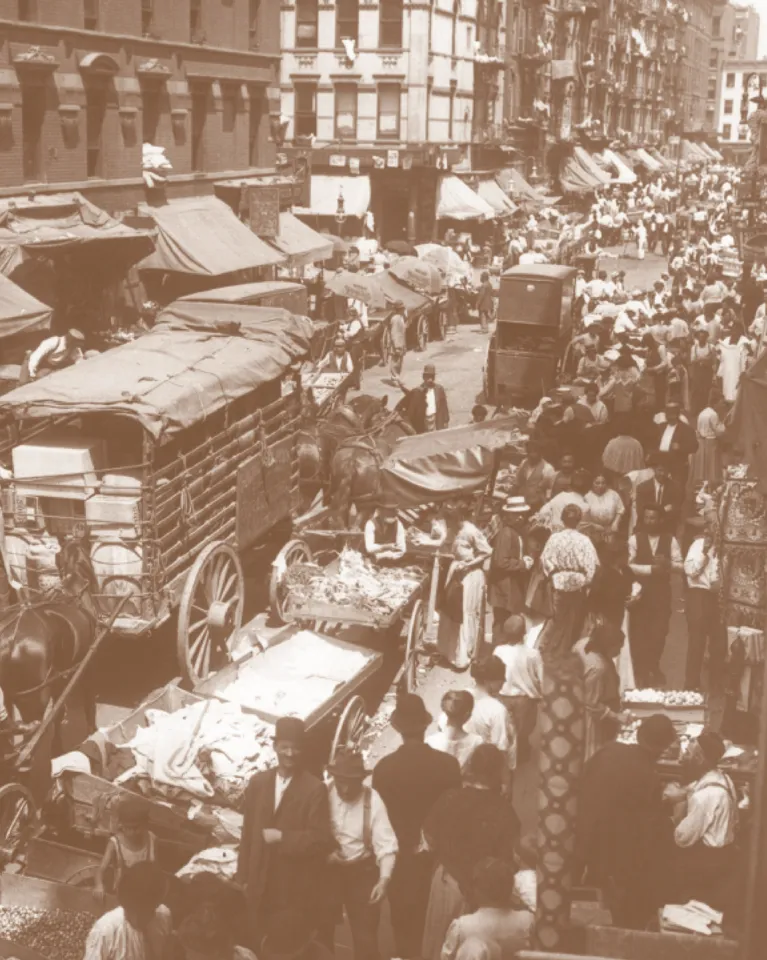
Opposite: Dorothea loved the bustling, noisy streets of Manhattan’s Lower East Side. “I would get so far on the way to school,” she said, “and then I’d turn and walk the streets.”
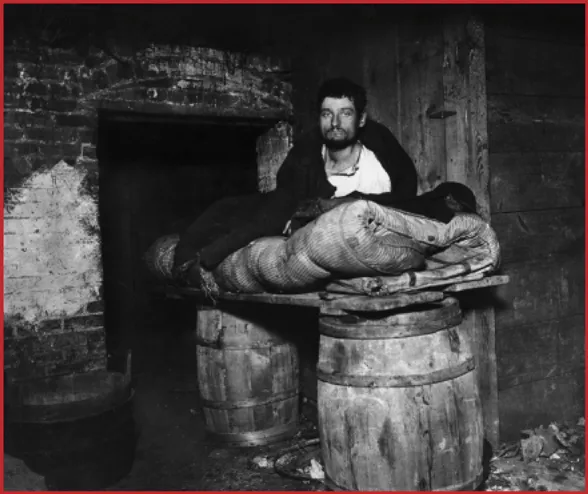
Dorothea was uneasy around the homeless men on
the Bowery, but that did not keep her away.
the Bowery, but that did not keep her away.
Often bored by school, Dorothea was not a very good student. She was much more interested in the crowded, noisy streets of Manhattan’s Lower East Side, where thousands of new immigrants filled the air with a cacophony of shouts, threats, laughter, songs, vendors’ calls, cries, and arguments. The years from 1890 to 1910 brought millions of hopeful newcomers from Eastern and Southern Europe—Poles, Russians, Greeks, Italians, and more. Most of these immigrants entered the United States at Ellis Island, a short distance from the inspiring Statue of Liberty.
After school, and on the countless days that she skipped school, Dorothea roamed the bustling streets. She found beauty and human interest even in the midst of the poverty and squalor. She was careful, and very frightened, when she had to thread her way among the drunken homeless men on the Bowery, a large, busy street on the Lower East Side of Manhattan. In later years, she wrote, “I realize how enriched I am through having been on the loose in my formative years. I have known all my life so many people who have always done what they should do, been proper, made the grades—and lost.”
Dorothea managed to complete just enough work in high school to graduate in 1914. Her mother, worried about her daughter’s future, asked what she planned to do. “I want to be a photographer,” Dorothea answered simply, even though she did not own a camera and had never taken a photograph. But her years of observing the details of life in New York had made her eager to capture what she saw in photographs. Her mother, however, was insistent that Dorothea study to be a teacher, one of the few careers open to women in the early 1900s. An unwilling Dorothea enrolled in the New York Training School for Teachers.
Dorothea remained determined to become a photographer, however. There were no schools of photography in those years, so she designed her own apprenticeship program. “I invented my own photographic schooling as I went along,” she recalled, “stumbling into most of it.”
Dorothea boldly went to the studio of Arnold Genthe, one of New York’s most famous portrait photographers. Although she had no experience, Genthe must have been impressed by her eagerness and intelligence. He hired her at a salary of $15 a week—a decent wage for part-time work in those days—and trained her in setting up the lights and operating the big, cumbersome camera.
Genthe also introduced Dorothea to some of New York’s wealthiest and most famous people. She learned to make these people feel comfortable during long sittings in front of the camera, and watched with fascination as Genthe worked his camera magic from all possible angles. Observing Genthe provided an important element in Lange’s approach to photography. Author Susannah Abbey stated it this way:
[Genthe] didn’t just snap their picture; he seemed to make the camera understand the people. This sense that an understanding of a subject was essential in making a portrait was truly the artistic part of photography, and something that Dorothea would take with her for the rest of her career.
After two years, Dorothea left Genthe’s studio and worked briefly with several other photographers. Each job taught her something new, and she also took one of the few photography courses available. The course, at Columbia University, was taught by another famous photographer—Clarence White. Although White did not communicate easily with his students, he helped Dorothea develop increasing confidence in her own ability.
Meanwhile, her teacher-training program was not going well. She disliked the stuffy classrooms and the endless lectures. Then, when she had to practice-teach a fifth-grade class, everything fell apart. The children quickly discovered that Dorothea did not know how to control them, so they began climbing out the window and down the fire escape to the playground. Her supervisor easily restored order, as Dorothea watched with tears of humiliation streaming down her face.

Arnold Genthe was one of New York’s most famous portrait photographers and Dorothea’s first teacher.
THE ART OF THE DARKROOM
Dorothea was convinced that in order to become a professional photographer she had to learn how to develop her own photographs. The technique proved more difficult than she had imagined, but with the help of the traveling photographer, she gradually mastered the fundamentals.
The first step was to cover the windows with thick black paper to make the room completely dark. A dim yellow lamp, called a safelight, provided enough light for her to remove the negatives from the camera and soak them in trays of “chemical baths.” Gradually, the image emerged. The image was in reverse, with black where white would be and vice versa.
Dorothea hung the negatives on a string until they were dry. She then placed each dry negative against a sheet of photographic paper and exposed it briefly to a bright light before placing the paper in a bath of developer. She rocked the tray gently, letting the developer wash over the emerging positive image on the paper. When she was satisfied that the contrast between black and white was right, she took the paper out of the bath, rinsed it, and hung it up to dry. The photograph was finished.
After this incident, even her mother was convinced that Dorothea was not cut out ...
Table of contents
- Cover
- Half Title
- Title Page
- Copyright Page
- Table of Contents
- In Her Own Words
- Map
- Chapter One A Photographer’s First Observations
- Chapter Two In Love with San Francisco
- Chapter Three The Great Depression
- Chapter Four Photographer of the People
- Chapter Five The Troubled War Years—and After
- Chapter Six Retrospective
- Glossary
- Time Line
- Further Research
- Bibliography
- Index
- About the Author